Welcome back to another Development Diary! This week we will talk about the Hordes that occupy the lands between the Pontic Steppe and Mongolia.
Before we start, I want to share with you some changes we made, based on the feedback we received since the last development diary:
- The formable countries that required Tech 20, will now be unlocked with Tech 18. This will affect all formable countries that previously required Tech 20.
- Andean Empire and Divine Kingship now allow their country to use to use Divine ideas instead of Aristocratic ideas.
- High-American nations will be able to benefit from Obsidian sources.
And with that, let's get into today's content.
By 1444, the era of Genghis Khan was long gone and only the remnants of its successor states populated the steppes. The descendants of the Yuan dynasty had found themselves under the Oirat Khanate, which would lead to a conflict with the Ming dynasty known as the Tumu Crisis; the Golden Horde had just recently disintegrated into various other states; the Uzbeks would begin their migration south into Bukhara after being beaten by the Sibirs and Kazakhs; and lastly, Moghulistan, the successor of the Chagatai Khanate, would be embroiled in a civil war.
Some of the historical events mentioned are already present in the game, such as the dwindling Tatar Yoke in Russia, the unrest of the Kazakh and Sibir people, and the Tumu Crisis in China. As the successors can roughly be split into three groups, the Successors of the Golden Horde, the Khans of Central Asia, and the Mongols of Northern Yuan in the East, we decided to create three separate branches for them.
Before discussing the content, I briefly want to mention a change to the nation of Chagatai. In 1444, the Khanate was splintered for multiple decades and the remnants were instead known as Moghulistan. For that reason, Chagatai is no more; instead, the nation has been renamed more appropriately:
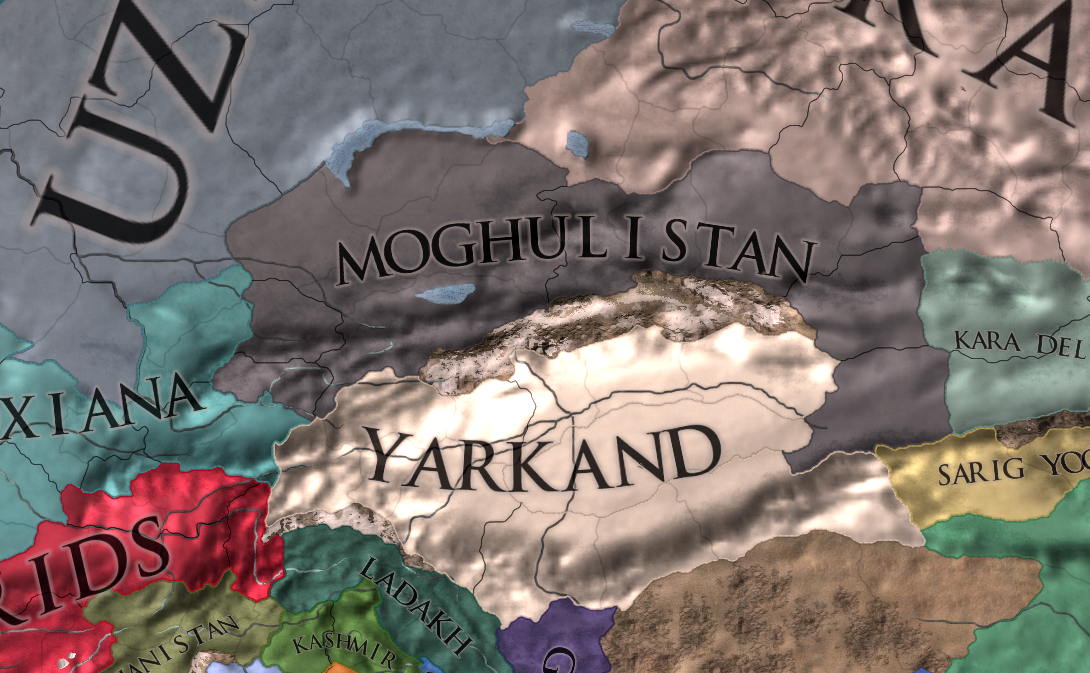
With that out of the way, let us start with the conquest trees. All the Horde mission trees share some common conquest missions, but depending on the region the overall progression will be different:
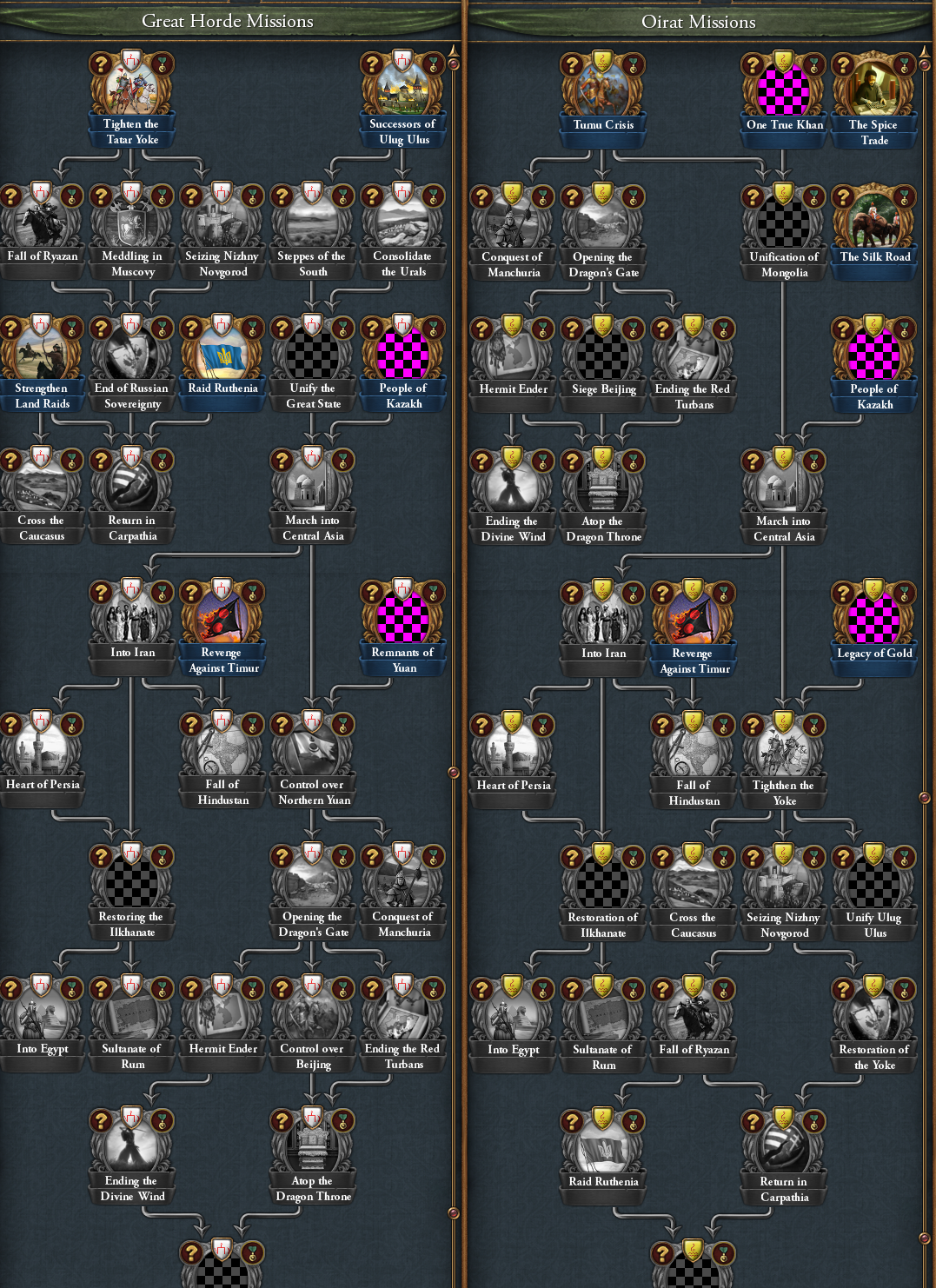
 Note: as always, all art shown in this Development Diary is placeholder.
Note: as always, all art shown in this Development Diary is placeholder.With the Golden Horde splintered, the nations of Crimea, Kazan, Great Horde, and Nogai will have their starting missions be about reuniting the lands there, as well as combating the increasing power of the Muscovites.
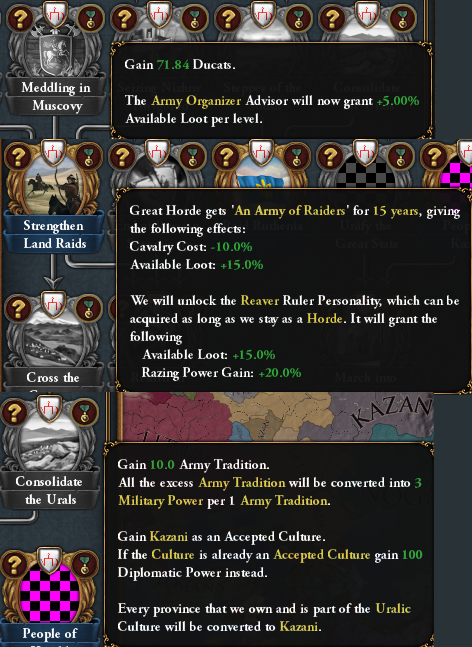
After your conquest of Russia and reaffirmation of the Tatar Yoke, you will be able to reach the furthest western extent of the Mongol Conquests into the Carpathian Basin.
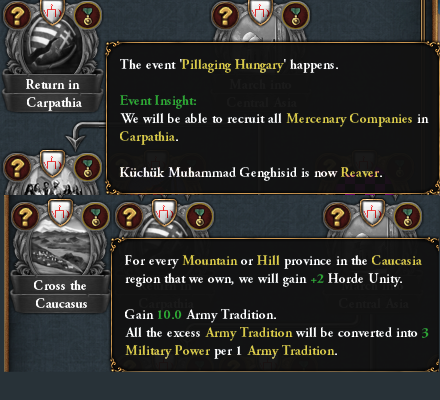
Having talked about the Western conquests, let’s now turn our attention to the east into the steppes of Central Asia and beyond if you want to assert your dominance of the hordes and restore the Mongol Empire.
For the Tatar Hordes, this will mean that their rewards will overlap with other hordes as well. Each Region of the Hordes will have access to a unique branch of their Conquest mission:
- Tatars will have unique missions about the Tatar Lands and Russia
- Central Asian Hordes have unique missions about Central Asia and Persia
- Oirat and Mongolia will have unique missions about China
These branches will not be absent for the others, for example, the Tatars and Central Asian Hordes will have access to the same mission tree concerning China, and the same goes for the other combination. So with all of that in mind, the next few missions will be shared with either Central Asian Hordes and Mongols.
With this explanation out of the way, let us look at the Central Asian and Chinese parts of the conquest tree. Central Asia in 1444 was much more split than what is shown in the game. The Kazakhs and Sibirs were effectively their own tribes, which is why that is represented for Uzbek as extra unrest. They were not made into independent nations at the start though; however, as both the Mongols and the Tatars you’ll be able to make Kazakh into your own subject through the tree, feeding them their core land should you wish to do that. Once you conquer most of Central Asia, you’ll be able to turn them into an incorporated vassal, which are subjects that are more closely aligned with your own country, making them cheaper to integrate.
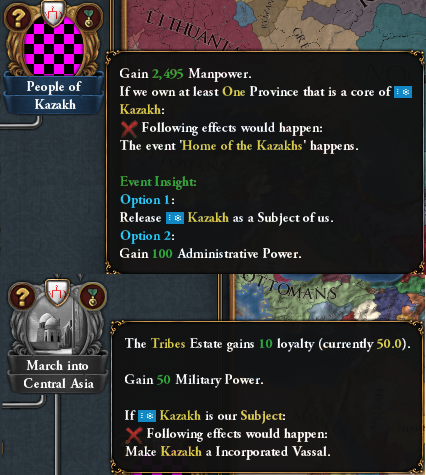
Moving on to the lands of China, you’ll be able to press the claims of the Yuan dynasty for yourself, making them a Mongol Brother Realm, as well as a new evolving modifier called ‘Like a Dragon’, that will help your nomadic playstyle once you conquer China. During your conquest, you will of course be able to adapt your country to the new challenges and people that are now part of your realm.
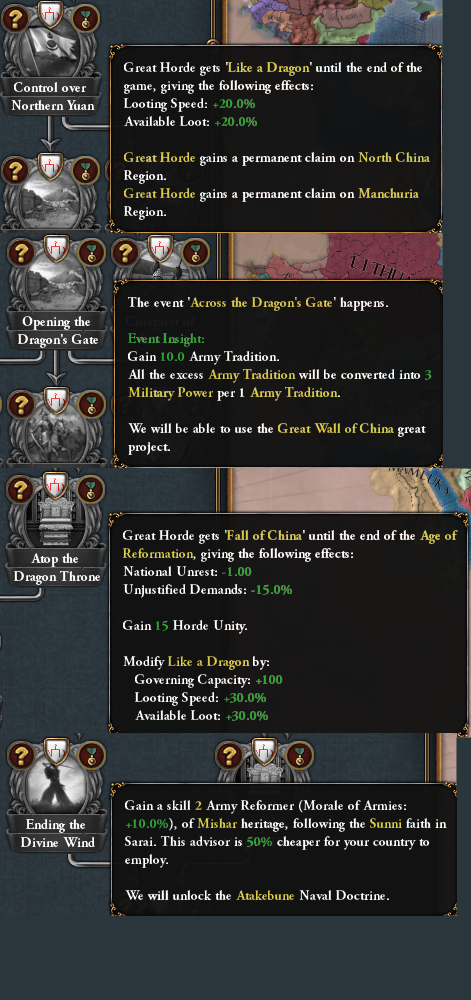
Going to the lands of Persia, the missions there will revolve around the re-establishment of the Mongol Rule and the Ilkhanate state which was destroyed before the era of Timur. Since the region is dominated by the Timurid dynasty and no direct successor, the Central Asian hordes will be able to reform the Ilkhanate TAG, should they ever wish to. As for the rest, they’ll be able to set up their own Brother Realm in the lands there. The missions there also allow you to go even further than the Mongols managed to, expanding your reach from Persia into Hindustan and Egypt.
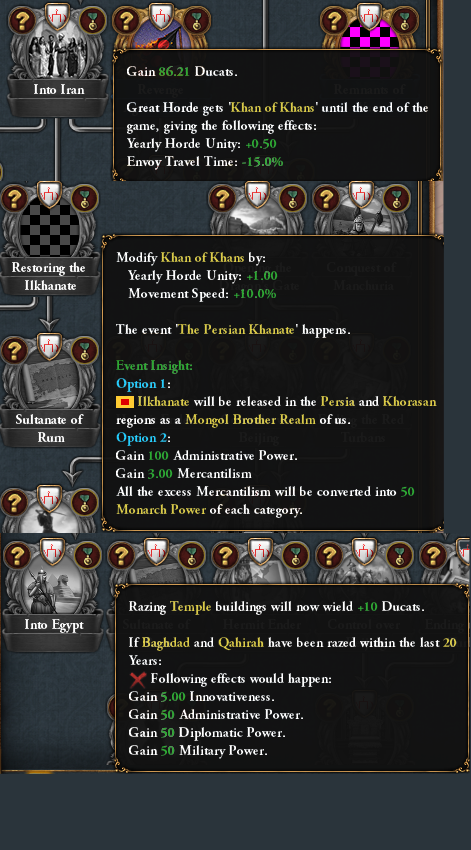
When you manage to unite all of the Mongol Empire you’ll be able to finish the last mission in the conquest part of the tree, ‘Pax Mongolica’. With the full force of a unified Mongol Empire under your control, the world will truly be the grazing ground for your horses.
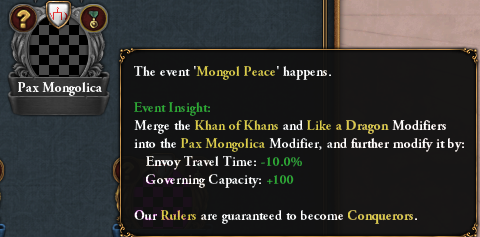
Before we proceed to the differences in the Mongol and Central Asian missions, the Mongol Empire has its requirements slightly changed. You will no longer be required to directly own all the Mongol Empire provinces but instead, you will be able to form them using subjects as well, since the Mongol Brother Realms would normally lock you from reforming the once great state, and for all Chagatai enthusiasts, Chagatai will be able to form them as well (more on that in the Central Asia part of the development diary). Additionally, the Tier 1 Great Mongol State reform that the Mongol Empire has will now give you access to Siberian Frontiers as well in order to make it possible to take the rest of the Siberian lands.
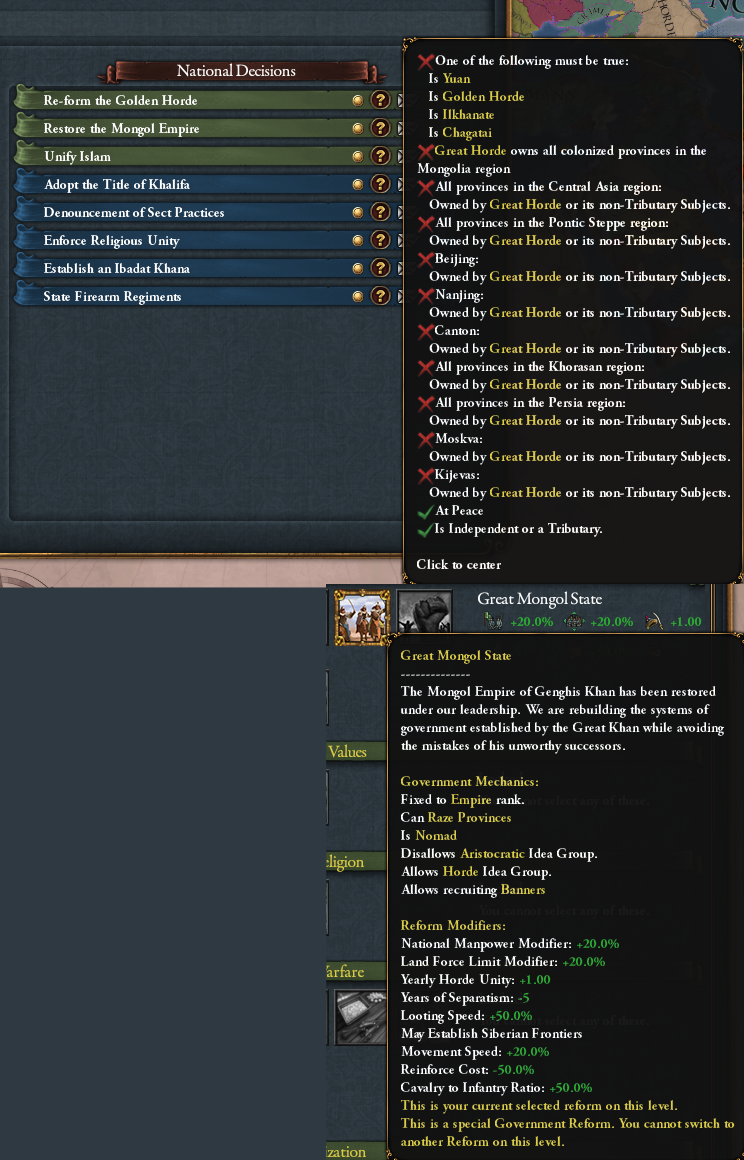
I mentioned the Mongol Brother Realm a few times and now it is time to explain a bit more in depth what these are. In order to allow for the player to have all of the successor states under one banner, the Ilkhanate, Golden Horde, and Yuan will now be able to become subjects under the strongest successor. They will provide little to no Liberty Desire but they will pay you extra money for being vassals, as well as provide bonuses to your cavalry. They will also be able to declare their own wars. While this is the intention to keep for now, we would like to hear your opinion on this subject and what you think.

Moving on from this, let us look at some of the differences between the Mongol and Central Asian sections, starting from the remnants of the Yuan dynasty.
The Oirat will now have a bit more options available during the Tumu Crisis. Should they be able to capture the Chinese emperor Zhu Qizhen they will be able to leverage his captivity for a justified conquest in China. The Tumu Crisis mission will allow you to transform your modifier “Captured the Emperor” to grant Core-Creation Cost and Province War Score Cost. The “Reuniting the Mongols” Event will also be present in the Mission Tree, allowing you to unify the Mongol cultures into one.
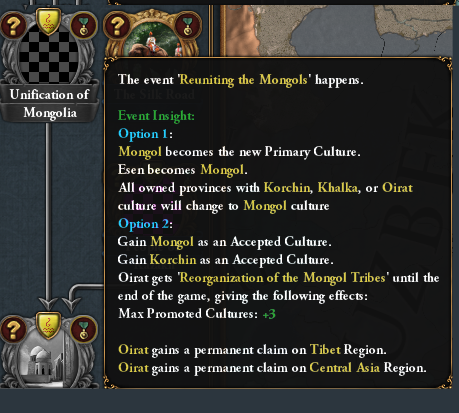
The Russian and Tatar section of the conquest for both Mongols and Central Asian Hordes will revolve around conquering the remnants of the Golden Horde and having the choice to make them a Mongol Brother Realm, as well as gaining the ability to recruit Cossacks.
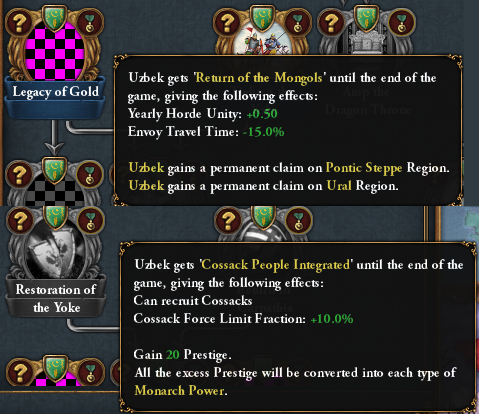
Lastly, let us look at the differences for Central Asians. As mentioned before, Chagatai had been fragmented during the 14th Century and Moghulistan survived as a successor state. You’ll be able to restore them should you complete the Unification of Chagatai mission, which will allow you to pursue forming the Mongol Empire. Other missions revolve around the Kazakhs as well as the central position of the Silk Road these nations sit in. Once you decide to move to Persia, you’ll also gain the choice to reform the Ilkhanate.

While conquest is no doubt a central part of any horde gameplay, this is not all the missions will have to offer, after all, conquest means nothing if you can’t stabilize the realm. A second part of the mission will delve into your internal administration and economic dealings. These will be available to all of the previously mentioned groups, while Yuan specifically has a different branch than the others. Additionally, a small tree of branching missions will offer you the choice between tolerance and devotion to your faith.
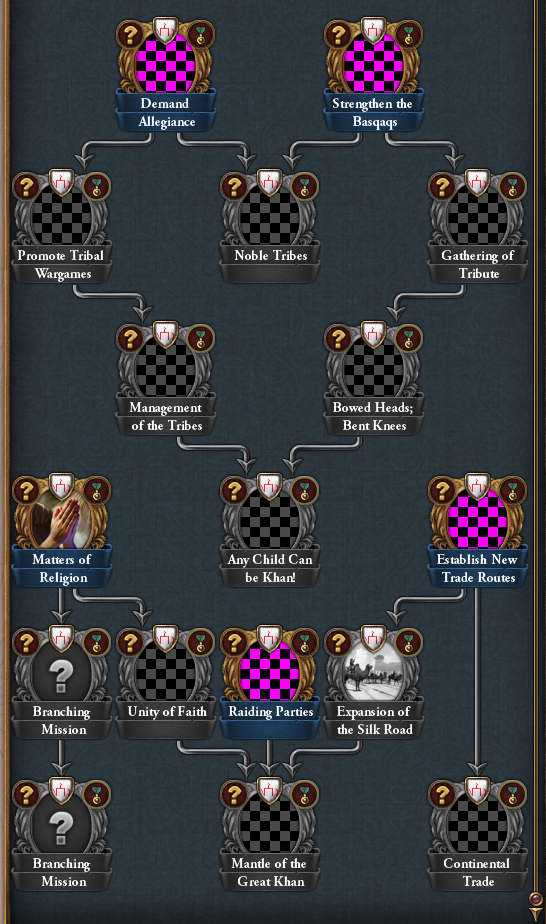
The Hordes had to rely on a tributary system to amass their wealth, and this is represented under the Strengthen the Basqaqs Mission. While Tributaries might not be a desirable long-term goal of your campaign, the additional rewards will be able to get your Host of Armies off the ground.
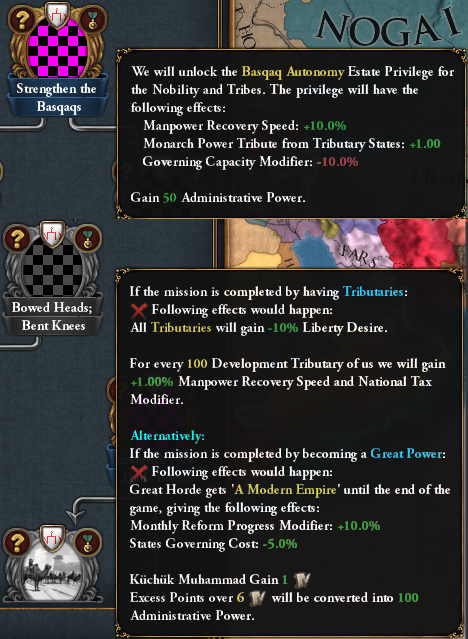
As the Horde Administration differs from a standard feudal society, the game struggled a bit with an accurate representation of this. These missions will allow you to adjust and reform your interactions with the Tribal Estate, elevating the nobles among the tribes, and getting rid of some of the destabilizing issues a horde will have to deal with at the start of the game. With things such as Tribal Absolutism, a privilege that benefits more from your Max Absolutism, giving you an incentive to keep your estate privileges to a minimum in order to make the most out of it, and forcing your Tribes to accept even the youngest child as the legitimate khan.
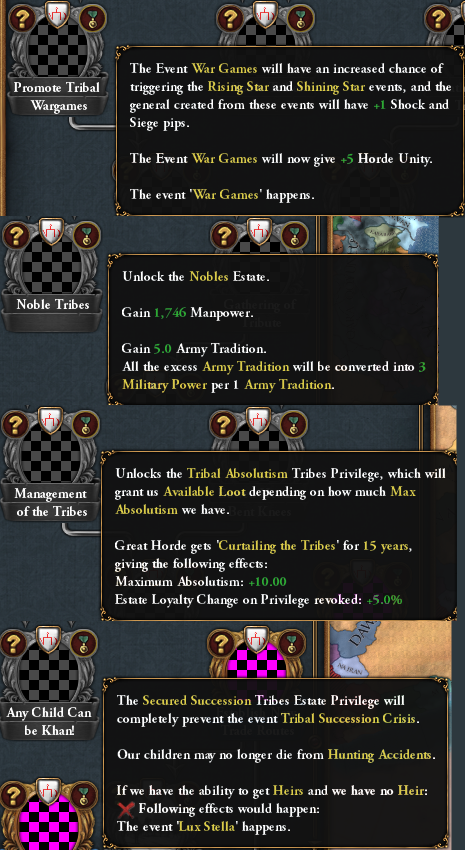
Something that is not inherently linked to your status as a horde, but the region you occupy, is the Silk Road and your control over the important trading posts of the regions. By controlling the important centers of trade along the Silk Road and its expansions into Persia you will be able to control the flow of trade between the eastern and western parts of your empire.
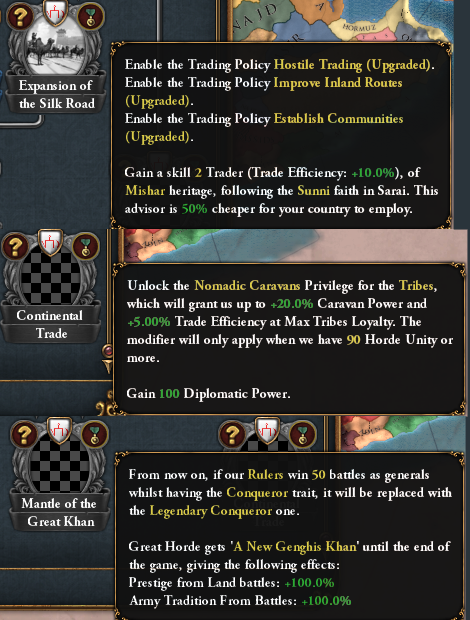
Lastly, let us talk about Yuan. When we worked on
Domination, it was very requested by the community to make available to them the new mission tree section for the Emperor of China. Now, we’ve decided that the owners of the new DLC will get access to the Emperor of China missions, and we're also making it possible for the owners of
Domination to have those missions available while playing with the old Mongol mission tree, which is part of the base game. Please, also remember that this is only working with the
Mandate of Heaven EoC mechanics, so you also need that DLC for them to appear and be playable.
This is not all that changes around Yuan, their flavor missions will be quite different in order to represent both the Mongol and Chinese character of the former dynasty.

In this combination, Yuan will have access to quite a sizable mission tree with 65 missions. The flavor part of the Yuan tree revolves around the mix of Chinese and Mongol characters that Yuan had, allowing you to be highly expansionist whilst also backing these conquests with a highly efficient bureaucracy.
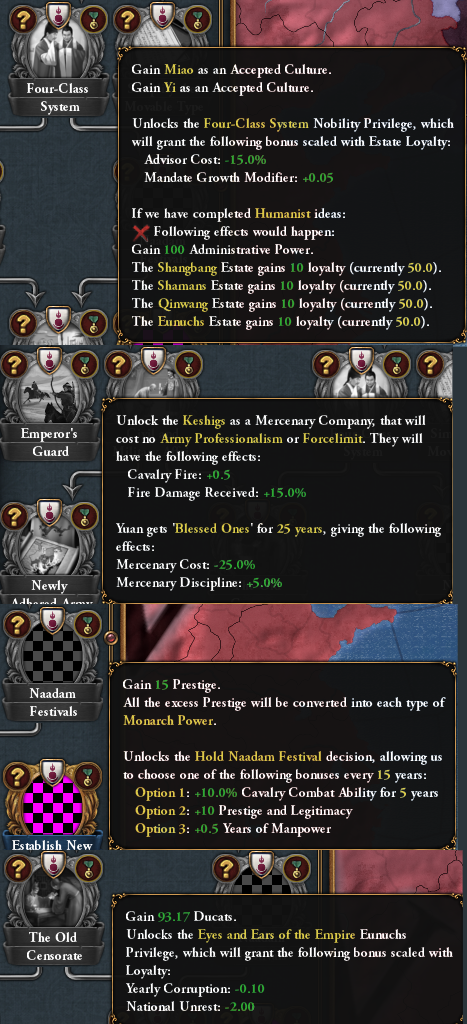
And this concludes this week's Development Diary! Next week Ogele will be back, showing off the content of the Timurids and Mughals!
Before we say goodbye, a word from FatherLorris. Let the army composition comments commence!!!





















